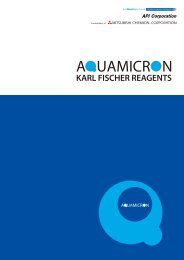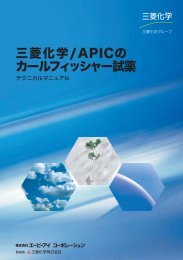Development of Karl Fischer Reagents
Development of Karl Fischer Reagents
Development of Karl Fischer Reagents
Create successful ePaper yourself
Turn your PDF publications into a flip-book with our unique Google optimized e-Paper software.
Chapter I: Basic Knowledge<br />
Chapter I: Basic Knowledge<br />
I-1. Questions & Answers about <strong>Karl</strong> <strong>Fischer</strong> <strong>Reagents</strong><br />
1. <strong>Karl</strong> <strong>Fischer</strong> Titration<br />
Q1<br />
What are the other methods currently available for the measurement <strong>of</strong><br />
moisture content? Please explain how these differ from <strong>Karl</strong> <strong>Fischer</strong><br />
titration?<br />
There are many ways <strong>of</strong> measuring moisture content. Methods based on<br />
new principles are still being announced. The following table lists the<br />
primary methods in current use. <strong>Karl</strong> <strong>Fischer</strong> titration is regarded as the<br />
most useful <strong>of</strong> these methods by virtue <strong>of</strong> its wide applicability and its<br />
capacity to measure absolute values. It is the focus <strong>of</strong> continuing research.<br />
Measurement method Measuring range Applications Interfering substances<br />
<strong>Karl</strong> <strong>Fischer</strong> titration A few ppm - 100%<br />
Drying<br />
0.01%<br />
Azeotropic distillation 0.05%<br />
Colorimetric method 0.1-a few %<br />
Infrared absorption 0.01-a few %<br />
Gas chromatography ppm-a few %<br />
Dew point method ppm-a few %<br />
Electrolysis<br />
1-1000ppm<br />
Electric resistance<br />
(Conductimetric method)<br />
0.3%-a few %<br />
Dielectric constant method 1-a few %<br />
Neutron scattering method a few %<br />
Quartz oscillation method 1-1000ppm<br />
Q2<br />
gases,liquids, solids Oxidizing,reducing substances<br />
solids<br />
Volatile substances, unstable substances<br />
liquids<br />
Volatile water-soluble substances<br />
solids, liquids Colored substances<br />
gases, liquids, solids Alcohol,amine, etc.<br />
gases, liquids<br />
Substances with the same retention capacity<br />
gases<br />
Condensable substances<br />
gases<br />
ROH, RCHO, NH3, HF<br />
gases, liquids Conductive substances<br />
gases, liquids<br />
solids<br />
gases<br />
Substances with high dielectric ratios<br />
Substances containing hydrogen<br />
Substances that<br />
react with sensing membranes<br />
Please explain briefly how moisture content is measured<br />
using <strong>Karl</strong> <strong>Fischer</strong> reagents?<br />
1. Methods<br />
There are two methods based on the use <strong>of</strong> <strong>Karl</strong> <strong>Fischer</strong> reagents, or <strong>Karl</strong><br />
<strong>Fischer</strong> titration, to measure moisture content.<br />
11




